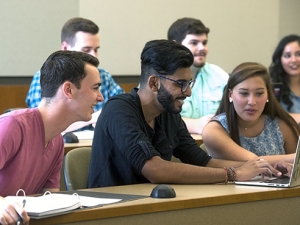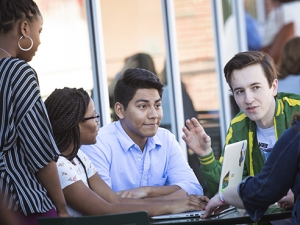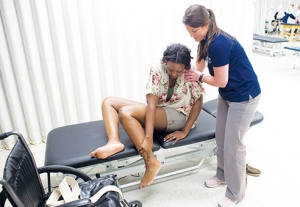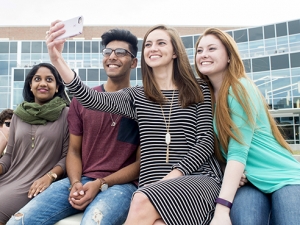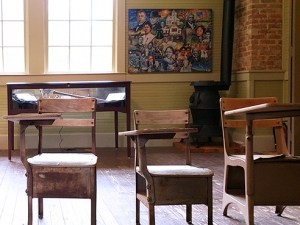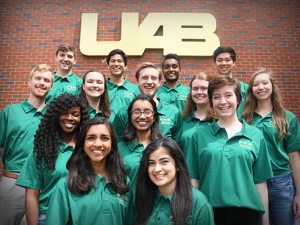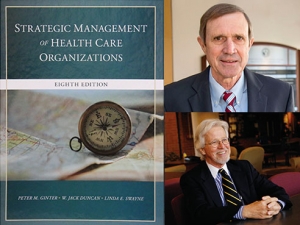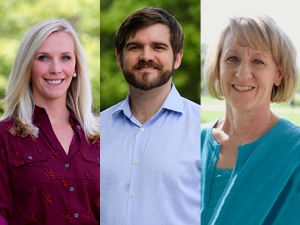 Students in the degree program have access to the Engineering Design lab, a 2,000-square-foot area reserved for students to work on design projects. Those who want to combine engineering and business education have that option with UAB’s master of engineering with a concentration in design and commercialization. The three-semester program couples a master’s degree from the School of Engineering with a graduate certificate in technology commercialization and entrepreneurship from the Collat School of Business.
Students in the degree program have access to the Engineering Design lab, a 2,000-square-foot area reserved for students to work on design projects. Those who want to combine engineering and business education have that option with UAB’s master of engineering with a concentration in design and commercialization. The three-semester program couples a master’s degree from the School of Engineering with a graduate certificate in technology commercialization and entrepreneurship from the Collat School of Business.Engineering Professor Alan Eberhardt, Ph.D., who is the director of the design and commercialization degree program, said developed the idea for launch in fall 2015 when he realized many UAB biomedical engineering students wanted to continue to work on the devices created for their senior design projects.
“I lead senior design in biomedical engineering, and the students make many devices that are good first prototypes,” Eberhardt said. Some who were not interested in going to med or grad school wanted to continue work on those projects, he said.
International students earning master’s degrees at UAB also wanted a design-centric degree option, he said. Nine students participated in the program’s first contingency, and five INTO UAB students are currently participating. Four new INTO students will begin in the fall.
Devices created by students in the program range from assistive technology devices such as attachable rain shelters for wheelchairs to more general devices such as a bendable catheter for stroke patients.
An eye for innovation
Most of the medical devices are designed for specific needs in the UAB and Birmingham community. When students begin the program, they meet with doctors, physical therapists or parents to identify and assess the need of the clinic or family and brainstorm ideas to meet it. "We train engineers who mean business," said Alan Eberhardt, a professor in the Department of Engineering and director of the degree program.At UAB students have access to world-class facilities to construct their devices, such as the Engineering and Innovative Technology Development laboratories, the Materials Processing and Applications Development Center and Makerspace.
"We train engineers who mean business," said Alan Eberhardt, a professor in the Department of Engineering and director of the degree program.At UAB students have access to world-class facilities to construct their devices, such as the Engineering and Innovative Technology Development laboratories, the Materials Processing and Applications Development Center and Makerspace.“All across UAB, people are working together to move innovation from the ground up with these student projects,” Eberhardt said. “If one person needs it, chances are a lot of people need it.”
From a course perspective, the degree is interdisciplinary and practical. It blends business concepts such as entrepreneurship and product commercialization with engineering skills such as 3-D printing, computer numerically controlled machining and CAD that enables students to make “sleek and sexy advertisements for their device,” Eberhardt said.
The students also learn hand-machining, how to use microcontroller systems and make printed circuit boards, all of which contribute directly to their device design and can be applied to their projects, he said.
The program also teaches students to analyze and correct for ease of use to improve the overall product design. Since the devices are often designed to be a solution to one specific local problem, this component of the program expands accessibility of the devices to make them potentially more useful by people with a variety of similar needs.
|
“We want to make the devices more user-friendly, marketable and attractive and often design, build, refine and rebuild.” |
“Part of the program is adjusting for universality,” Eberhardt said. “The students set out to meet this one need, but then the market analysis often shows the need is more universal. We want to make the devices more user-friendly, marketable and attractive and often design, build and rebuild.”
A well-educated workforce
Eberhardt said students who possess these types of skills are uniquely attractive to potential employers, and many of these students who complete elective internships at engineering companies often are hired by them upon graduation or start their own businesses.Beyond that, he said both large companies and more local start-ups have innovation teams that are interested in developing solutions for community needs, and this type of training comes in handy.
“We train engineers who mean business — who will be attractive in the industry and are interested in starting their own business. They understand intellectual property, regulatory processes, business models and how to move the device through the process. And they’re engineers,” Eberhardt said. “They’re actually making stuff.”

